The AMD Radeon RX 480 Preview: Polaris Makes Its Mainstream Mark
by Ryan Smith on June 29, 2016 9:00 AM ESTPower, Temperature, & Noise
Given AMD’s focus on power efficiency with Polaris – not to mention the overall benefits of the move to 14nm FinFET – there is a lot of interest in just how the RX 480 stacks up when it comes to power, temperature, and noise. So without further ado…

When it comes to idle power consumption I'm posting the results I've measured as-is, but I want to note that I have low confidence in these results for the AMD cards. Ever since the GPU testbed was updated from Windows 8.1 to Windows 10, AMD cards have idled 3-5W higher than they used to under Windows 8.1. I believe that this is an AMD driver bug – NVIDIA’s cards clearly have no problem – possibly related to the GPU tested being an Ivy Bridge-E system. In this case I don’t believe RX 480’s idle power consumption is any higher than GTX 960’s, but for the moment the testbed is unable to prove it.
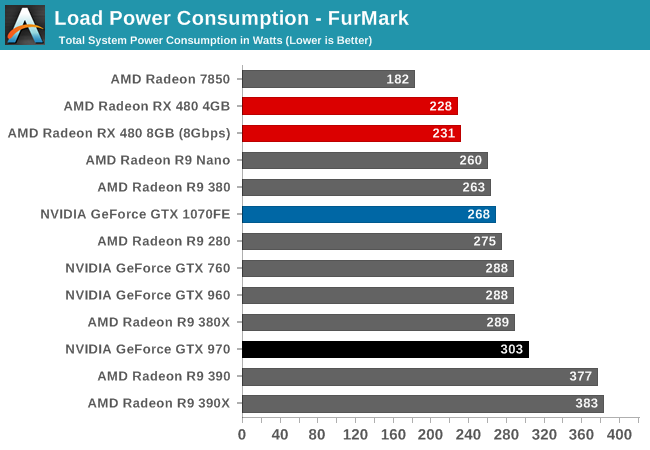
Traditionally we start with gaming load power before moving on to FurMark, but in this instance I want to flip that. As a power virus type workload, FurMark’s power requirements are greater than any game. But because it’s synthetic, it gives us a cleaner look at just GPU power consumption.
Among AMD’s cards, the RX 480 is second to only the Radeon HD 7850 in power consumption. Even then, as a GCN 1.0 card, the 7850 is one of the last AMD cards without fine-grained power states, so this isn’t a true apples-to-apples comparison. Instead a better point of reference is the GCN 1.2 based R9 Nano, which has a 175W TBP. Compared to the R9 Nano we find that the RX 480 draws about 30W less at the wall, which almost perfectly translates to the 25W difference in TBP. As a result we can see first-hand the progress AMD has made on containing power consumption with Polaris.
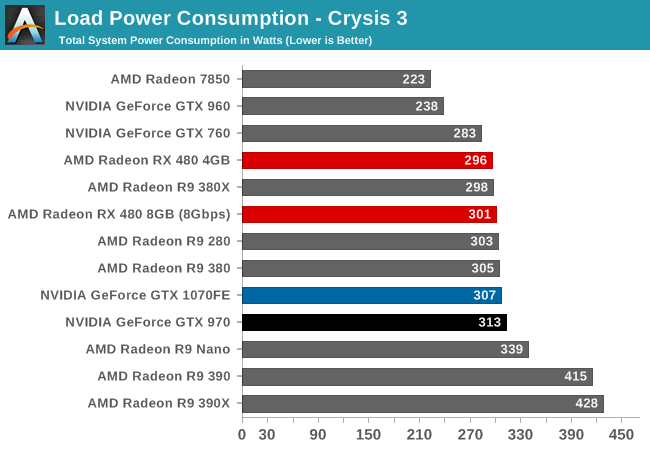
However things are a bit more mixed under Crysis 3. RX 480 is still near the top of our charts, and keeping in mind that higher performing cards draw more power on this test due to the additional CPU workload, the RX 480 compares very favorably to the rest of AMD’s lineup. System power consumption is very close to R9 280/380 for much improved performance, and against the performance-comparable R9 390, we’re looking at over 110W in savings. Hawaii was a solid chip from a performance standpoint, and Polaris 10 picks up where that left off by bringing down the power consumption to much lower levels.
The drawback for AMD here is that power consumption compared to NVIDIA still isn’t great. At the wall, RX 480 is only about 10W ahead of the performance-comparable GTX 970, a last-generation 28nm card. 1070FE further complicates matters, as its performance is well ahead of RX 480, and yet its power consumption at the wall is within several watts of AMD’s latest card. Given what we saw with FurMark I have little reason to believe that card-level power consumption is this close, but it looks like AMD is losing out elsewhere; possibly with driver-related CPU load.
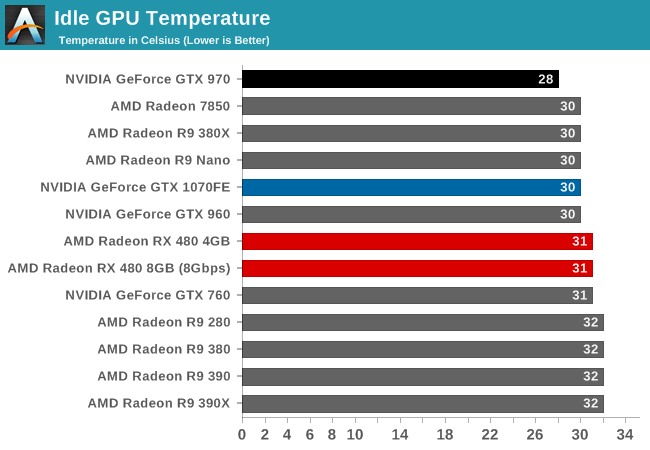
Moving on to idle GPU temperatures, there’s little to remark on. At 31C, the RX 480’s blower based design is consistent with the other cards in our lineup.
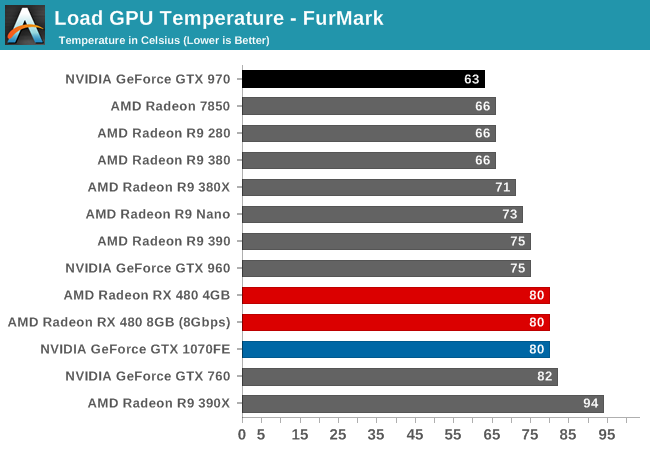
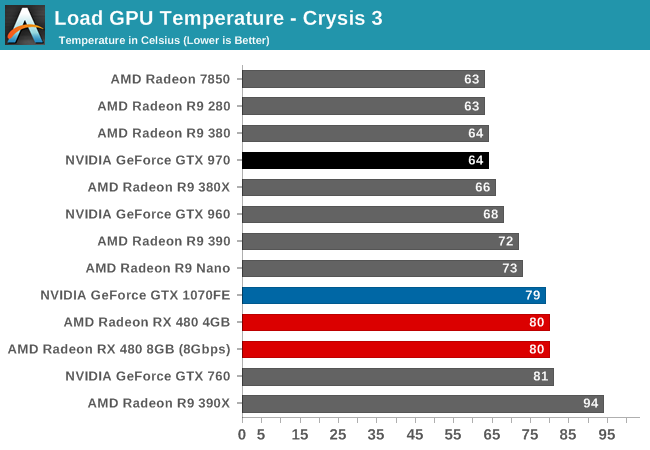
Meanwhile with load temperatures, we get to see the full impact of AMD’s new WattMan power management technology. The RX 480 has a temperature target of 80C, and it dutifully ramps up the fan to ensure it doesn’t exceed that temperature.

With idle noise levels RX 480 once again posts a good result. At 37.8dB, it’s in good company, only meaningfully trailing cards that idle silently due to their respective zero fan speed idle implementations.
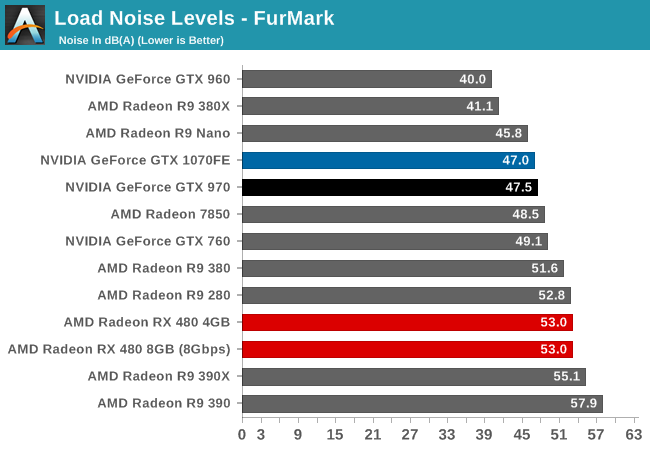
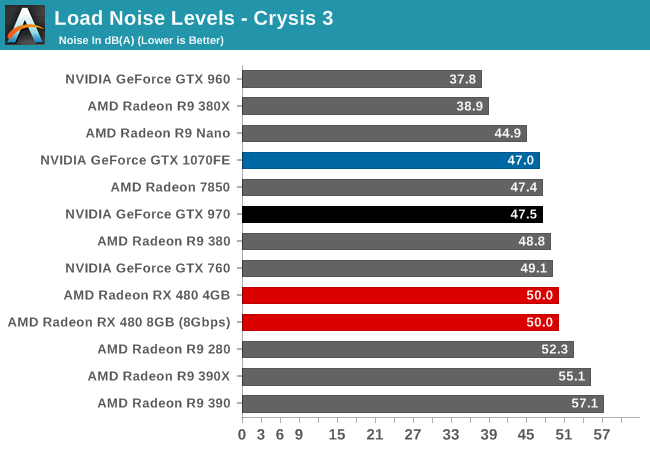
Finally, with load noise levels, RX 480 produces middling (but acceptable) results. Given that we have a mix of blowers and open air coolers here, the RX 480 performs similarly to other mainstream blower based cards. The $199 price tag means that AMD can’t implement any exotic cooling or noise reduction technologies, though strictly speaking it doesn’t need them.










449 Comments
View All Comments
D. Lister - Thursday, June 30, 2016 - link
@fanofanandWhat he is saying is, that the total power draw of the 2x 1080 from the motherboard is less than 75W, because they take most of the power from the 8-pin connectors, which is true. The same statement is also true for the Radeon 290X, a GPU well-known for massive power use. But even 2x 290/290Xs don't draw so much from the board.
Please refrain from abusive language and think before you post, because it only puts you, your argument and your brand of choice, in a negative light.
fanofanand - Friday, July 1, 2016 - link
You are choosing to scold me for calling him out on his word choices that portray an inaccurate statement? Of all the people on here and all the things they say? Mr. Lister, kindly F off.D. Lister - Saturday, July 2, 2016 - link
:) well, no one who has ever scolded me, used the word "please". Anyhow, you misunderstood the guy, didn't conduct any research in the matter, and instead of replying with an opposing argument/reference you asked for his post to be deleted and then called him an idiot. Acting like that only serves to push you in a weaker position, and drags AT down to the level of places like wccftech. Anyway, I will now kindly F off.Murloc - Tuesday, July 5, 2016 - link
lol what he says puts "his brand of choice" in negative light'guys please get a grip
D. Lister - Tuesday, July 5, 2016 - link
Yeah, complicated, but you'll figure it out once you're done laughing out loud. :)Mode+ - Thursday, June 30, 2016 - link
Standard 12V 6 pin connector is rated up to 192W without the HCS terminals. The specification is for 150W. It's a guideline, not a rule.TheinsanegamerN - Thursday, June 30, 2016 - link
And my car is rated to go up to 120MPH. Doesnt mean that it will work well for long at that speed.Rumpeltroll80 - Monday, July 4, 2016 - link
That is why many are releasing the RX 480 with a 8 pin instead of 6 pin. 150 Watt on a 8 pin, only 75 watt on a 6 pin.So problem seems to be solved then right? Here is one card with the change
http://www.tweaktown.com/news/52878/sapphires-upco...
komplik - Thursday, June 30, 2016 - link
Really? https://www.techpowerup.com/reviews/AMD/RX_480_Cro...In average... slower than single 1070
erple2 - Friday, July 1, 2016 - link
I didn't see that from the charts - I saw it to be faster. Personally, I ignored resolutions below 1440p, as buying 2 of these for those resolutions seems pointless.In the aggregate including games where there was no crossfire scaling, the 1070 was competitive, and slightly faster.